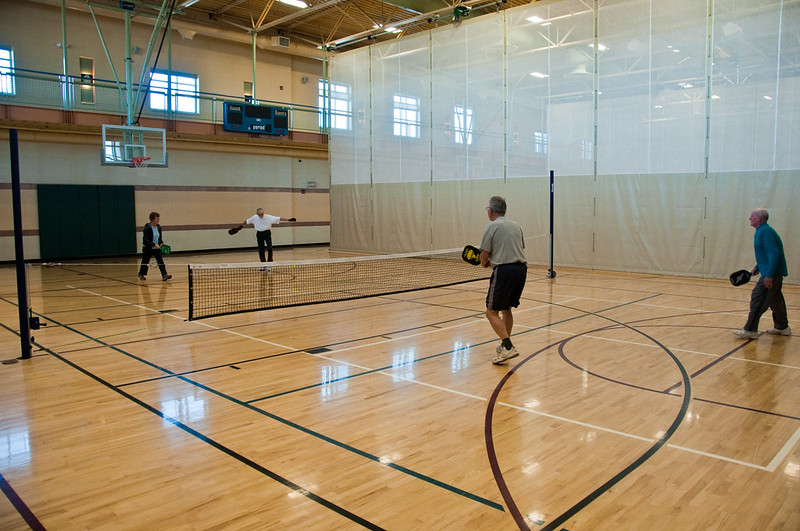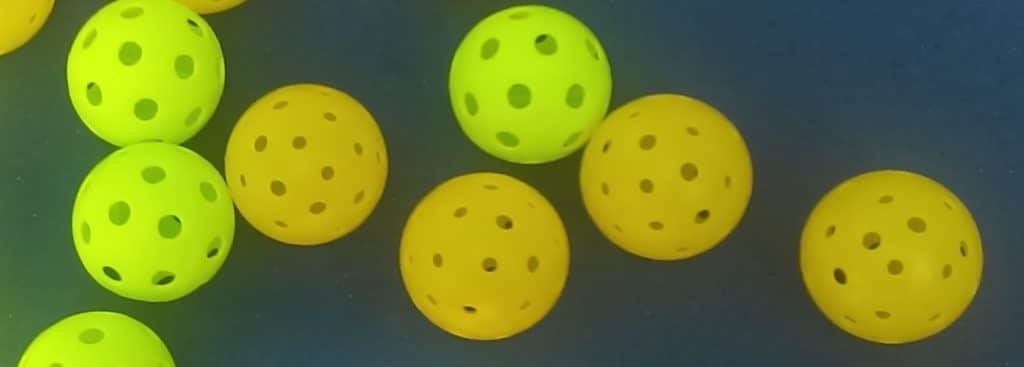
What’s the difference between indoor and outdoor pickleballs?
Table of Contents
- What kind of ball is used in Pickleball?
- Outdoor pickleball ball characteristics
- Indoor pickleball balls characteristics
- How can you tell the difference between an indoor and an outdoor pickleball?
Pickleball is one of the few sports – if not the only sport – I know of that have different balls that are best suited for whether you are playing indoors or outdoors.
There are a lot of choices when it comes to balls for both indoor and outdoor – but at least you only need one type of racket whether you’re playing indoors or outdoors! (Check out our pickleball paddle recommendations: Best Pickleball Paddles for Beginners And Paddle Buying Guide.)
What kind of ball is used in Pickleball?
Pickleball is played with plastic balls that are reminiscent of whiffle balls with a number of holes in them and with different types of indoor vs outdoor pickleballs that are best suited for where you are playing.
While you obviously won’t get arrested for playing with the “wrong” type of ball, why not play with the best ball for the type of court you’re on?
Pickleball ball colors are all over the map so you can get just about any color (or multi-color) ball you want — but read until the end of this article to find out why even the ball color matters. They are usually made to be a bright color so that they are easy to see: yellow, orange and bright green are probably the most common color balls.

So getting to it: what’s the difference between indoor and outdoor pickleballs?
Outdoor pickleball ball characteristics
- Made from harder, smoother plastic to help make them last longer in the elements
- Heavier and less affected by wind
- Have smaller, more numerous holes which helps with wind resistance outside
- Allow for harder hitting and faster shots – though with less control
- Bounce higher
- Make more noise
Indoor pickleball balls characteristics
- Tailored for smoother indoor court surfaces and the still air of indoor playAre made from softer plastic
- Lighter
- Have larger, fewer holes
- Don’t bounce as high
- Allow for more control in your serve – though with less power, that can lead to longer rallies than a more hard-hitting outdoor game
- Hurt less if you get hit by one!
If you’re brand new to the game, you will benefit from buying a variety pack and trying out different styles of balls in different contexts. And keep in mind that depending on the ball, it might take a bit of playing with a brand new ball before it gets to its ideal condition.
You also shouldn’t feel too worried about being stuck with any particular ball because depending on how hard you are playing and the type of ball, balls can become unplayable after just a couple of games.
So why not buy a handful of different brands of balls to try them out?
Although it’s less common, you might be the type who prefers one type of ball over another regardless of whether you are indoors or outdoors. If you want more control and longer rallies, go with indoor; if you are more interested in harder hitting and less concerned about control, go with outdoor.
Beware, though: if you’re playing indoors on a wood surface, outdoor balls may skid around so you are will have better luck going with an indoor ball on wood surfaces.
How can you tell the difference between an indoor and an outdoor pickleball?
You can usually tell by looking at them: biggest giveaway is that the indoor pickleballs have larger holes while the outdoor pickleballs have smaller holes.
The number of holes can also be an indicator – the range of holes on a ball can be between 26 and 40 – indoor balls will tend towards the lower end of that scale with outdoor balls tending towards the upper.
One thing to note if you want to start competing: the most common ball used in competition is the Dura Fast 40 outdoor ball. (And this ball actually has 2 different sized holes.) If you want to compete, start practicing with that type of ball to get the closest tournament experience possible.
Be aware: there are, as of this writing, 33 pickleball brands that are approved by the USAPA/IFP for tournaments. This is a list of both indoor and outdoor pickleballs that have been tested out and deemed appropriate for officially sanctioned play. To be absolutely sure if you’re practicing with the right pickleball, check with your specific tournament to find out what they will be playing with.
If you’re not playing in a tournament any time soon, go nuts and buy whatever ball you want!
And one more thing to remember: similar to tennis balls (though for different reasons), pickleballs wear out! Despite being made of pretty durable plastic, balls do crack and wear down, so it’s best to have a few on hand as backups.
Even though outdoor pickleballs are more durable they do need to be replaced more often since they will degrade from sun exposure and more unforgiving surfaces. If you’re playing hard on a rough outdoor court, an outdoor ball might only last a few games since it might crack or go out of round, which means it isn’t perfectly circular anymore. When it is out of round it won’t fly in as consistent a manner as it did when it was new.
Temperature can also play a factor: the colder it is the more likely it is for an outdoor ball to crack.
You can test if a ball is out of round by hitting it straight up in the air (when your racket is parallel to the ground) with a bit of spin on it. If it veers off course on it’s way down, assuming there is no wind, the ball is likely out of round.)
And finally, on the other hand, if you’re playing indoors and are not playing hard, indoor balls could last through weeks or months of play, at which point they can get too soft to play well.
Just kidding, there is one more thing to consider which may have an affect on your game that I alluded to before: the color of the ball. It’s not just a personal preference thing. Be cognizant of the ambient light and background colors of where you’re playing. You might benefit from a more brightly colored ball for playing outdoors – particularly if it’s getting dark — and a more darkly colored ball for playing indoors. Look at the color of the court and the color of the surrounding areas – like if there are trees or walls, etc.
It’s a small thing but if you’re looking for every possible edge to improve your game, it’s at least worth considering.
Given the differences in ambient light and the surrounding background colors, it can make a difference in visibility of the ball while you play. It will depend on the exact context of where you’re playing so keep it in mind.
Happy pickleballing!
Shop Related Products Gamma Sports Photon Indoor Pickleballs, High-V…$9.74 (73)
Gamma Sports Photon Indoor Pickleballs, High-V…$9.74 (73) Onix Fuse Indoor Orange Pickleballs 6 Pack$20.49 (67)
Onix Fuse Indoor Orange Pickleballs 6 Pack$20.49 (67) Set of 12 White Regulation Size Practice Baseballs …$14.99 (83)
Set of 12 White Regulation Size Practice Baseballs …$14.99 (83) Faswin 50 Pack White Plastic Golf Training Ball…$11.79 (65)Ads by Amazon
Faswin 50 Pack White Plastic Golf Training Ball…$11.79 (65)Ads by Amazon
